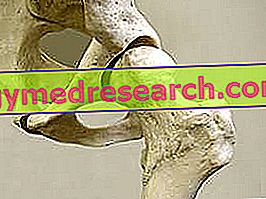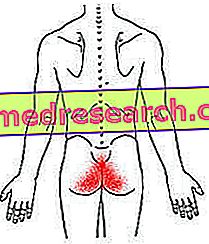By Dr. Luca Franzon
The hip is the proximal joint of the lower limb. Located at the level of the pelvis, it connects the head of the femur with the acetabular cavity.
The hip belongs to the enarthritis family, it is in fact a type of articulation that has two articular surfaces, a concave and a convex one, kept in contact by a fibrous capsule reinforced by ligaments. Arthrosis is the most mobile joints in the human body: it allows flexion-extension, adduction-abduction, intrarotation-external rotation and circumduction movements.

The great possibility of movement that characterizes the hip, derives from the fact that this articulation is crossed by three axes, on which the various movements are performed. These axes are:
- Vertical axis: on which extra-rotation is performed
- Transverse axis: on which flexion-extension is carried out
- Sagittal axis: on which abduction-adduction is performed
ANCA MOVEMENTS | |
active knee flexion extended 90 ° | |
active flexion with flexed knee> 120 ° | |
passive flexion at extended knee always exceeds 120 ° | |
passive flexion at flexed knee exceeds 140 ° | |
20 ° passive extension | |
active extension 20 ° with extended knee | |
10 ° active extension with flexed knee | |
20 ° extended knee passive extension | |
30 ° passive extension flexed knee pulled backwards. | |
active abduction 45 ° | |
180 ° passive abduction | |
adduction is possible only if accompanied by a slight flexion or extension of the hip. since the adduction movement depends on the degree of flexion or extension of the hip there is no mention of typical angular excursion. | |
90 ° external rotation with bent knee | |
internal rotation varies from 30 ° to 40 ° | |
The femoral head, spherical in shape, has a diameter of 40-50 mm, and is attached to the diaphysis through the neck. The acetabular cavity has the shape of a hemisphere and is surrounded by the cotyloid eyelash which serves to increase its capacity. The whole is stabilized and covered by the joint capsule.
The joint capsule appears as a cylindrical sleeve stretched between the ileum and upper extremity of the femur. The extremity has the shape of a sleeve that from the cotyloid eyelash, is inserted in the anterior intertrochanteric line and in the posterior intertrochanteric line. The joint capsule is reinforced both anteriorly and posteriorly by powerful ligaments:
anteriorly from the ilio-femoral ligament (Bertin) and from the pubo-femoral ligament; posteriorly from the ischio-femoral ligament

Precisely because of its great mobility and given that it is a joint that bears considerable loads (being located at a strategic point in our body that receives influences both from below and from above), the hip is an articulation often subject to degenerative pathology.
Osteoarthritis of the hip, is a pathology that is manifested above all in the population over 50 years, however it is not rare to find the same problem in much younger subjects. The pathology is given by the early wear of the joint heads. It usually occurs with pain in the affected joint or near musculature. The pain is greater in the morning, it is attenuated with movement, it can be awakened after exertion and it is generally relieved during the night.
Subsequently, joint function becomes limited, first by pain, then by obstacles of a mechanical nature, which can prevent the performance of normal activities or make even the usual functions of relationship life difficult.
The reduction of the articular rhyme is the first sign of cartilage damage and can allow the diagnosis of initial arthrosis. Subsequently the other not always evident radiological symptoms are observed. The presence of osteophytes and the deformities of the joint are a sign of long-standing osteoarthritis, which ends with the ankylosis of the radiologically evident joint.
The evolution of the pathology often leads to having to undergo surgery to which an adequate recovery phase must follow in order to return to a condition as similar as possible to the physical condition preceding the operation and the onset of the pathology.
Of fundamental importance, before starting a rehabilitation program, is the consultation with the surgeon who performed the operation, to obtain permission to begin this phase and the indications to be followed during the recovery period. Once allowed, it is equally essential to perform physiotherapy therapies and rehabilitation to regain the greatest possible joint function. Subsequently, always subject to medical authorization, a phase of muscle recovery, joint mobility and all conditional and coordinative abilities must be started, so as to be able to resume daily activities without particular problems or limitations.
The first exercises that can be performed are the following:
TO THE GROUND
- Flexed foot extensions
- Foot circumferences clockwise and counterclockwise
- From the extended leg, bend the knee and the hip without lifting the heel from the ground (do it well with the stockings on a smooth surface)
- Isometric contractions of the femoral quadriceps. Maintain the contraction for 6 -10 '' with a rest of 4-5 '' between repetitions.
- Contract the quadriceps muscle and keeping it contracted, lift the lower limb about 20 cm. Stay in that position for 8-10 ".
- Contract the quadriceps muscle and keeping it contracted, lift the lower limb about 20 cm by drawing in the air numbers, letters or geometric figures
- Abductions slipping on a smooth surface without detaching the lower limb from the ground supporting a chair, armchair or a bar on the wall.
Perform 15 repetitions per exercise, starting with 1/2 series to arrive in time to perform 4 series. When you get to the 4 series add the following exercises:
- Hip bends less than 90 ° while maintaining the position for a few seconds.
- Hip extensions without arching the back. Holding the position a few seconds.
- Hip abductions keeping the knee and foot straight.
Always perform 15 repetitions starting with 2 sets to get to 4. To enter the following exercises later:
Elastic hip extensions
Elastic hip abductions
Elastic hip flexions
Later replace the rubber bands with anklets full of sand. Always start with 2 sets of 15 to get to 4 series. It will be good in this period to also perform 10 minutes of bike at the beginning and end of training, keeping the saddle very high or starting with the pedaling backwards. Water gymnastics is also welcome.
At this point you should be in a position to practice everyday activities without major problems by regaining your freedom and independence. If the checks are successful, the upgrade can be increased.



